Qing Zhang
Structural Energy-Guided Sampling for View-Consistent Text-to-3D
Aug 23, 2025Abstract:Text-to-3D generation often suffers from the Janus problem, where objects look correct from the front but collapse into duplicated or distorted geometry from other angles. We attribute this failure to viewpoint bias in 2D diffusion priors, which propagates into 3D optimization. To address this, we propose Structural Energy-Guided Sampling (SEGS), a training-free, plug-and-play framework that enforces multi-view consistency entirely at sampling time. SEGS defines a structural energy in a PCA subspace of intermediate U-Net features and injects its gradients into the denoising trajectory, steering geometry toward the intended viewpoint while preserving appearance fidelity. Integrated seamlessly into SDS/VSD pipelines, SEGS significantly reduces Janus artifacts, achieving improved geometric alignment and viewpoint consistency without retraining or weight modification.
Harnessing the Power of Interleaving and Counterfactual Evaluation for Airbnb Search Ranking
Aug 01, 2025Abstract:Evaluation plays a crucial role in the development of ranking algorithms on search and recommender systems. It enables online platforms to create user-friendly features that drive commercial success in a steady and effective manner. The online environment is particularly conducive to applying causal inference techniques, such as randomized controlled experiments (known as A/B test), which are often more challenging to implement in fields like medicine and public policy. However, businesses face unique challenges when it comes to effective A/B test. Specifically, achieving sufficient statistical power for conversion-based metrics can be time-consuming, especially for significant purchases like booking accommodations. While offline evaluations are quicker and more cost-effective, they often lack accuracy and are inadequate for selecting candidates for A/B test. To address these challenges, we developed interleaving and counterfactual evaluation methods to facilitate rapid online assessments for identifying the most promising candidates for A/B tests. Our approach not only increased the sensitivity of experiments by a factor of up to 100 (depending on the approach and metrics) compared to traditional A/B testing but also streamlined the experimental process. The practical insights gained from usage in production can also benefit organizations with similar interests.
* 10 pages
Omni-Fusion of Spatial and Spectral for Hyperspectral Image Segmentation
Jul 09, 2025Abstract:Medical Hyperspectral Imaging (MHSI) has emerged as a promising tool for enhanced disease diagnosis, particularly in computational pathology, offering rich spectral information that aids in identifying subtle biochemical properties of tissues. Despite these advantages, effectively fusing both spatial-dimensional and spectral-dimensional information from MHSIs remains challenging due to its high dimensionality and spectral redundancy inherent characteristics. To solve the above challenges, we propose a novel spatial-spectral omni-fusion network for hyperspectral image segmentation, named as Omni-Fuse. Here, we introduce abundant cross-dimensional feature fusion operations, including a cross-dimensional enhancement module that refines both spatial and spectral features through bidirectional attention mechanisms, a spectral-guided spatial query selection to select the most spectral-related spatial feature as the query, and a two-stage cross-dimensional decoder which dynamically guide the model to focus on the selected spatial query. Despite of numerous attention blocks, Omni-Fuse remains efficient in execution. Experiments on two microscopic hyperspectral image datasets show that our approach can significantly improve the segmentation performance compared with the state-of-the-art methods, with over 5.73 percent improvement in DSC. Code available at: https://github.com/DeepMed-Lab-ECNU/Omni-Fuse.
Retrospective Memory for Camouflaged Object Detection
Jun 18, 2025Abstract:Camouflaged object detection (COD) primarily focuses on learning subtle yet discriminative representations from complex scenes. Existing methods predominantly follow the parametric feedforward architecture based on static visual representation modeling. However, they lack explicit mechanisms for acquiring historical context, limiting their adaptation and effectiveness in handling challenging camouflage scenes. In this paper, we propose a recall-augmented COD architecture, namely RetroMem, which dynamically modulates camouflage pattern perception and inference by integrating relevant historical knowledge into the process. Specifically, RetroMem employs a two-stage training paradigm consisting of a learning stage and a recall stage to construct, update, and utilize memory representations effectively. During the learning stage, we design a dense multi-scale adapter (DMA) to improve the pretrained encoder's capability to capture rich multi-scale visual information with very few trainable parameters, thereby providing foundational inferences. In the recall stage, we propose a dynamic memory mechanism (DMM) and an inference pattern reconstruction (IPR). These components fully leverage the latent relationships between learned knowledge and current sample context to reconstruct the inference of camouflage patterns, thereby significantly improving the model's understanding of camouflage scenes. Extensive experiments on several widely used datasets demonstrate that our RetroMem significantly outperforms existing state-of-the-art methods.
Cuddle-Fish: Exploring a Soft Floating Robot with Flapping Wings for Physical Interactions
Apr 02, 2025Abstract:Flying robots, such as quadrotor drones, offer new possibilities for human-robot interaction but often pose safety risks due to fast-spinning propellers, rigid structures, and noise. In contrast, lighter-than-air flapping-wing robots, inspired by animal movement, offer a soft, quiet, and touch-safe alternative. Building on these advantages, we present \textit{Cuddle-Fish}, a soft, flapping-wing floating robot designed for safe, close-proximity interactions in indoor spaces. Through a user study with 24 participants, we explored their perceptions of the robot and experiences during a series of co-located demonstrations in which the robot moved near them. Results showed that participants felt safe, willingly engaged in touch-based interactions with the robot, and exhibited spontaneous affective behaviours, such as patting, stroking, hugging, and cheek-touching, without external prompting. They also reported positive emotional responses towards the robot. These findings suggest that the soft floating robot with flapping wings can serve as a novel and socially acceptable alternative to traditional rigid flying robots, opening new possibilities for companionship, play, and interactive experiences in everyday indoor environments.
DomainCQA: Crafting Expert-Level QA from Domain-Specific Charts
Mar 25, 2025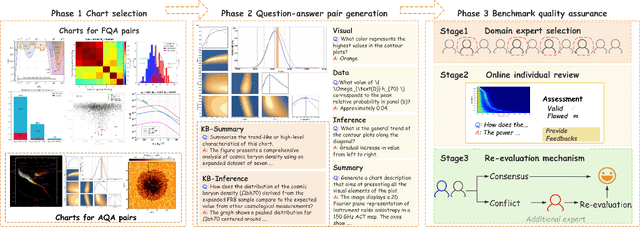

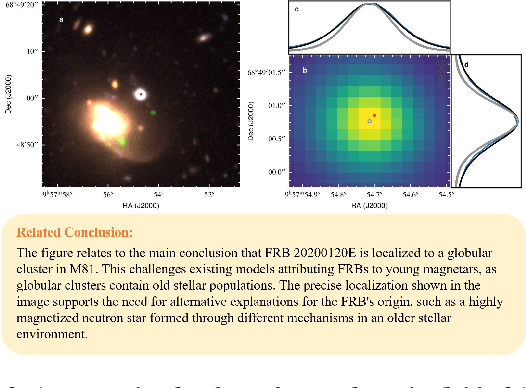

Abstract:Chart Question Answering (CQA) benchmarks are essential for evaluating the capability of Multimodal Large Language Models (MLLMs) to interpret visual data. However, current benchmarks focus primarily on the evaluation of general-purpose CQA but fail to adequately capture domain-specific challenges. We introduce DomainCQA, a systematic methodology for constructing domain-specific CQA benchmarks, and demonstrate its effectiveness by developing AstroChart, a CQA benchmark in the field of astronomy. Our evaluation shows that chart reasoning and combining chart information with domain knowledge for deeper analysis and summarization, rather than domain-specific knowledge, pose the primary challenge for existing MLLMs, highlighting a critical gap in current benchmarks. By providing a scalable and rigorous framework, DomainCQA enables more precise assessment and improvement of MLLMs for domain-specific applications.
RoGSplat: Learning Robust Generalizable Human Gaussian Splatting from Sparse Multi-View Images
Mar 18, 2025
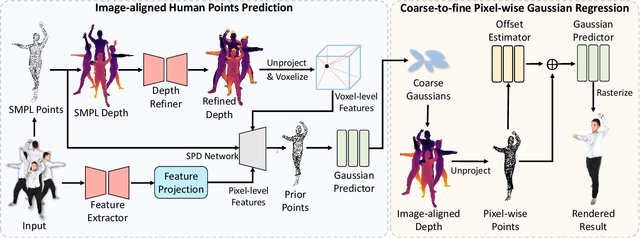

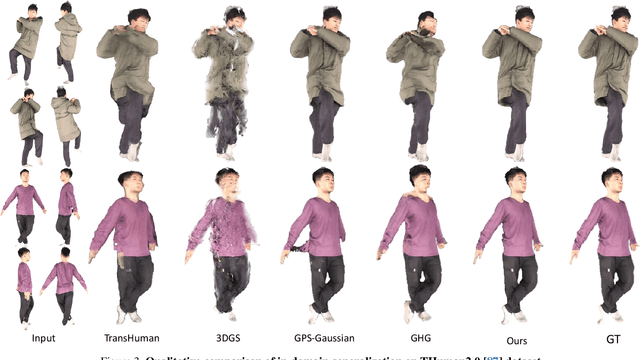
Abstract:This paper presents RoGSplat, a novel approach for synthesizing high-fidelity novel views of unseen human from sparse multi-view images, while requiring no cumbersome per-subject optimization. Unlike previous methods that typically struggle with sparse views with few overlappings and are less effective in reconstructing complex human geometry, the proposed method enables robust reconstruction in such challenging conditions. Our key idea is to lift SMPL vertices to dense and reliable 3D prior points representing accurate human body geometry, and then regress human Gaussian parameters based on the points. To account for possible misalignment between SMPL model and images, we propose to predict image-aligned 3D prior points by leveraging both pixel-level features and voxel-level features, from which we regress the coarse Gaussians. To enhance the ability to capture high-frequency details, we further render depth maps from the coarse 3D Gaussians to help regress fine-grained pixel-wise Gaussians. Experiments on several benchmark datasets demonstrate that our method outperforms state-of-the-art methods in novel view synthesis and cross-dataset generalization. Our code is available at https://github.com/iSEE-Laboratory/RoGSplat.
CGCOD: Class-Guided Camouflaged Object Detection
Dec 25, 2024


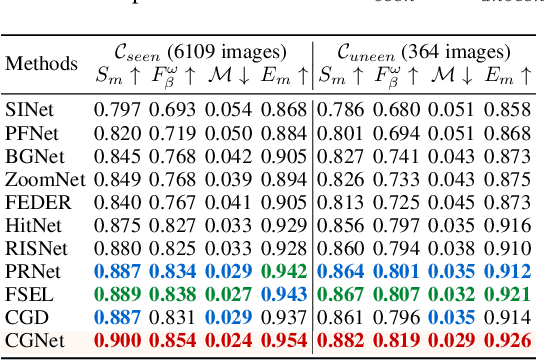
Abstract:Camouflaged Object Detection (COD) is designed to identify objects that blend seamlessly with their surroundings. Due to the complexity of camouflaged objects (such as shape, color, and texture), their semantic cues are often blurred or completely lost, posing a significant challenge for COD. Existing COD methods often rely on visual features, which are not stable enough in changeable camouflage environments. This instability leads to false positives and false negatives, resulting in incomplete or inaccurate segmentation results. In this paper, to solve this problem, we propose a new task, Class-Guided Camouflaged Object Detection (CG-COD), which extends the traditional COD task by introducing object class knowledge, significantly improving the robustness and segmentation accuracy of the model in complex environments. Toward this end, we construct a dataset, CamoClass, containing the camouflaged objects in the real scenes and their corresponding class annotation. Based on this, we propose a multi-stage framework CGNet which consists of a plug-and-play class prompt generator and a class-guided detector. Under the guidance of textual information, CGNet enables efficient segmentation. It is worth emphasizing that for the first time, we extend the object class annotations on existing COD benchmark datasets, and introduce a flexible framework to improve the performance of the existing COD model under text guidance.
Acquisition of Spatially-Varying Reflectance and Surface Normals via Polarized Reflectance Fields
Dec 13, 2024



Abstract:Accurately measuring the geometry and spatially-varying reflectance of real-world objects is a complex task due to their intricate shapes formed by concave features, hollow engravings and diverse surfaces, resulting in inter-reflection and occlusion when photographed. Moreover, issues like lens flare and overexposure can arise from interference from secondary reflections and limitations of hardware even in professional studios. In this paper, we propose a novel approach using polarized reflectance field capture and a comprehensive statistical analysis algorithm to obtain highly accurate surface normals (within 0.1mm/px) and spatially-varying reflectance data, including albedo, specular separation, roughness, and anisotropy parameters for realistic rendering and analysis. Our algorithm removes image artifacts via analytical modeling and further employs both an initial step and an optimization step computed on the whole image collection to further enhance the precision of per-pixel surface reflectance and normal measurement. We showcase the captured shapes and reflectance of diverse objects with a wide material range, spanning from highly diffuse to highly glossy - a challenge unaddressed by prior techniques. Our approach enhances downstream applications by offering precise measurements for realistic rendering and provides a valuable training dataset for emerging research in inverse rendering. We will release the polarized reflectance fields of several captured objects with this work.
An Entailment Tree Generation Approach for Multimodal Multi-Hop Question Answering with Mixture-of-Experts and Iterative Feedback Mechanism
Dec 10, 2024Abstract:With the rise of large-scale language models (LLMs), it is currently popular and effective to convert multimodal information into text descriptions for multimodal multi-hop question answering. However, we argue that the current methods of multi-modal multi-hop question answering still mainly face two challenges: 1) The retrieved evidence containing a large amount of redundant information, inevitably leads to a significant drop in performance due to irrelevant information misleading the prediction. 2) The reasoning process without interpretable reasoning steps makes the model difficult to discover the logical errors for handling complex questions. To solve these problems, we propose a unified LLMs-based approach but without heavily relying on them due to the LLM's potential errors, and innovatively treat multimodal multi-hop question answering as a joint entailment tree generation and question answering problem. Specifically, we design a multi-task learning framework with a focus on facilitating common knowledge sharing across interpretability and prediction tasks while preventing task-specific errors from interfering with each other via mixture of experts. Afterward, we design an iterative feedback mechanism to further enhance both tasks by feeding back the results of the joint training to the LLM for regenerating entailment trees, aiming to iteratively refine the potential answer. Notably, our method has won the first place in the official leaderboard of WebQA (since April 10, 2024), and achieves competitive results on MultimodalQA.
* Erratum: We identified an error in the calculation of the F1 score in table 4 reported in a previous version of this work. The performance of the new result is better than the previous one. The corrected values are included in this updated version of the paper. These changes do not alter the primary conclusions of our research
 Add to Chrome
Add to Chrome Add to Firefox
Add to Firefox Add to Edge
Add to Edge